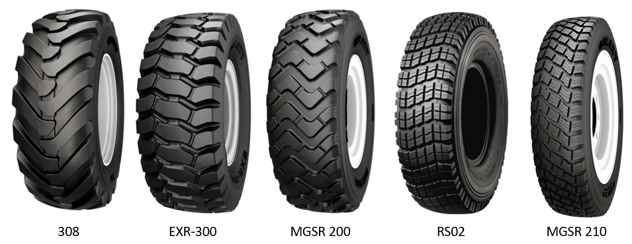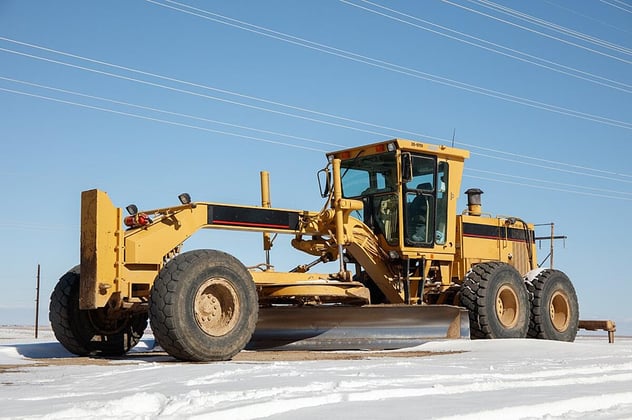OTR Tires Help Make the Grade
What do you call a county engineer with a motor grader? A highway department. There is a lot of truth to this old joke. Motor graders are used for everything from the construction of roads to the maintenance of them in both municipal and civil applications, as well as in industries like mining. Consequently, motor graders are also commonly called road graders. Ensuring this valuable piece of equipment makes the grade are its tires.
Grader Tires
Like other construction equipment, motor graders have grown in size, power, and speed over the years. While this has improved the productivity and efficiency of graders, it has also increased the demand placed on tires. Today’s grader tires need to handle the extra weight of larger equipment and heavier attachments, along with effectively transferring the rising amounts of horsepower and torque to the ground.
Grader tires also face challenges from the terrain they work in. Grader tires need to provide traction while traveling at speeds up to 25 mph everywhere from the harsh, hard-packed landscapes that commonly surround mines to muddy construction sites to snowy parking lots. Additionally, grader tires also must provide reliable operation, reduce downtime, and deliver a long service life.
An undervalued aspect of grader tire performance is operator comfort. Tires play a considerable role in ride quality and the right set of tires can make operators more productive and happy. With equipment operators in high demand and short supply, operator satisfaction is something every construction company should keep in mind. Better ride quality isn’t just good for operators, it’s also good for graders and can help reduce maintenance costs.
G (Grader) Tires
The Tire and Rim Association (TRA) has adopted a uniform classification system that is adhered to by all manufacturers to ease the understanding of a tire’s intended application. Tires for use with motor graders are classified as G (grader). Grader tires are rated to travel unlimited distances at speeds up to 25 mph and are engineered to deliver traction and directional stability.
The TRA also indicates the tread depth and type of compound of grader tires with a number. Together, these two designations provide a clear picture of the purpose of a tire.
|
Tread Type |
Features |
|
G-1 |
Standard tread depth |
|
G-2 |
Standard tread depth; built with a directional tread pattern for better traction |
|
G-3 |
Standard tread depth; built with an S-shaped tread pattern and engineered for increased durability and enhanced resistance to scrapes and impacts |
|
G-4 |
150% deeper than the standard tread depth; engineered for enhanced cut and wear resistance |
For example, a G-2 Traction tire is best for road maintenance applications, while a G-4 tire is ideal for severe service. It’s common to see dual-marked tires, or tires classified for use with graders along with another type of machine, such as our Galaxy Giraffe XLM G-2/L-2 tire which is for use with both motor graders and backhoes.
Bias vs. Radial Grader Tires
Bias tires have long been the go-to tire for motor graders, however, radial tires are making inroads.
Bias Grader Tires
Because of the way they’re constructed, bias tires have stiffer sidewalls than radials. Most notably, this provides bias tires with the greatest resistance to cuts and tears along the sidewall, which is particularly beneficial to machines working in rugged, rocky areas where sidewall punctures are common. Another reason bias tires are appealing is their lower upfront cost and wide availability—they’re simply affordable and typically in stock when it’s time to buy new grader tires.
Radial Grader Tires
Radial tires often have a higher initial cost than bias tires, but they can provide numerous benefits. Most notably delivering a lower total cost of ownership. Radials can operate at lower inflation pressures, which enables them to put a larger footprint on the ground and more evenly distribute the weight of the grader. The large contact patch of radials also increases traction, lowers fuel costs, and improves productivity. Radial tires are also more puncture-resistant and can carry heavier loads over longer distances at higher speeds than their bias-ply counterparts.
Tread Patterns
Grader tires come in a variety of patterns, with each delivering varying degrees of traction, flotation, and durability.
- Traction Pattern: Featuring the classic overlapping bar lugs, traction pattern tires, like our Alliance 308 provide graders with stability and traction while operating on rough surfaces.
- Rock Pattern: One of the most common off-the-road tread patterns, tires like our Galaxy EXR 300 are engineered to minimize damage by rocks while maximizing traction with S- or Z-shaped lugs that run from sidewall to sidewall. Another tire with a rock tread pattern is the Galaxy MGSR 200, which combines the classic tread pattern with radial construction to deliver a tire that minimizes heat build-up—the number one enemy of tires—and excels in non-stop applications.
- Block Pattern: A popular option for use in soft and muddy terrain, block patterns feature wide treads, have open shoulders, and provide good flotation. Some block tread pattern tires, like our Yokohama OTR RS02, are constructed with siping for improved performance in snow and ice. The Galaxy MGSR 210 is another notable block tread tire that shines in the snow thanks to its radial construction, aggressive non-directional block pattern, special rubber compound, and sipes.

The Right Mix of Tires
Graders are sensitive machines, and mismatched tires can cause a multitude of issues including excessive drivetrain wear, premature tire wear, increased fuel consumption, and underperformance. Ideally, all the tires on a motor grader are the same type (bias/radial), tread type, and age.
About Inflation
Inflation pressure plays a major role in the life and performance of all OTR tires, but it plays an especially important role in motor grader tires. If inflation pressures aren’t equalized, it can affect the calibration of grade control systems and negatively impact traction and machine performance.
Optimally, the tires of motor graders are monitored daily and at a minimum, inflation should be checked weekly. Inflation is best checked when the tires are “cold,” typically at the beginning of the day and before a machine has been run. Understand the weight of the grader, its attachments, and the speed it will travel, and consult load tables or work with your tire dealer to calculate the ideal air pressure for your grader tires.
The Mark of a Great Tire
Whether it’s a local municipality or a multinational mining company, motor grader owners care about cost, and here is where Yokohama Off-Highway Tires America (YOHTA) can help. Our motor grader tires deliver the high performance, long service life, and low total cost of ownership that fleet owners love. Contact your local YOHTA dealer or rep today to learn more about how our grader tires flatten the competition.


